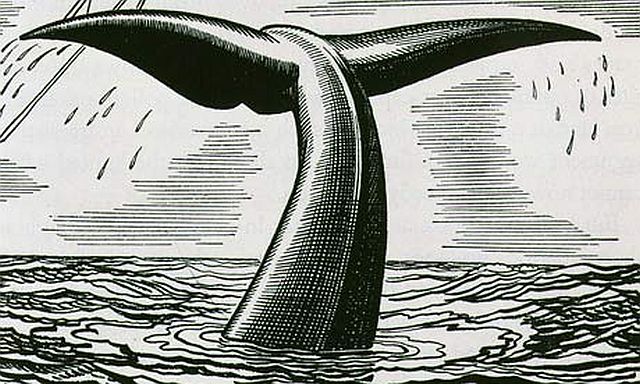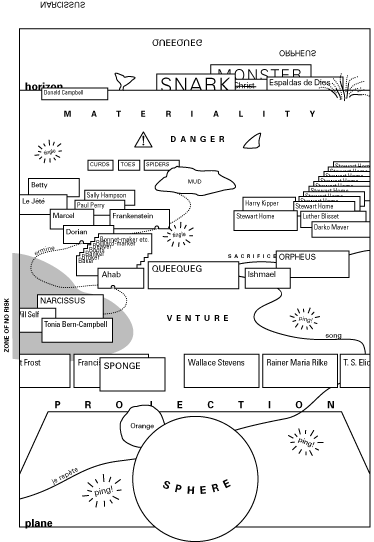Whale in the Moon When It’s Clear
American artist, illustrator and adventurer Rockwell Kent wrote that Glenlough, County Donegal was ‘a place never to be forgotten – a place, indeed, to be remembered with nostalgia.’1 Kent sojourned there in 1926, ‘painting in a remote and all but inaccessible coastal valley … lived there in a tiny one-room house, painted the surrounding countryside and the great cliffs that dropped almost a sheer thousand feet into the sea.’ It was in Dan Ward’s2 converted cow barn he completed some of what are now considered to be his best paintings: ‘And Women Must Weep,’ ‘Annie McGinley,’ ‘Dan Ward’s Stack.’ was also in this year that Kent was approached that year to produce an illustrated edition of Moby-Dick.
A failure on publication in 18513, Melville’s magnum opus was enjoying something of a comeback with ex-pats in twenties’ Europe (and Kent’s handsome edition, published in 1930 with its two-hundred-and-eighty woodcuts, assured Moby-Dick’s rebirth). Moby-Dick, says Nathaniel Philbrick,4 ‘in its wilful refusal to follow the usual conventions of nineteenth-century fiction, … possessed the experimental swagger that so many authors were attempting to capture in the years after World War I,’ and D.H. Lawrence was an enthusiastic admirer: ‘[Melville] was a futurist long before futurism found paint.’ ‘At first you are put off by the style,’ Lawrence concedes. ‘It reads like journalism. seems spurious. You feel Melville is trying to put something over you. It won’t do. And Melville really is a bit sententious: aware of himself, self-conscious, putting something over even himself. But then it’s not easy to get into the swing of a piece of deep mysticism when you just set out with a story.’
Rockwell Kent tried to purchase Dan Ward’s cottage in the fifties but was refused a passport by the US State Department and became embroiled in an eight-year battle against his government, who he claimed were keeping him in ‘continental imprisonment,’ a struggle Melville would have approved of (he won in the end, but the cottage was sold to another). We know of Kent—of his radicalism, his popularity in Moscow, his appearance before the House of Un-American Activities (‘believing that the world should live at peace and that atom bombs could never prove the instruments of peace’)—because we were failing to engage with Moby-Dick and were reading around the text. Not uncommon—‘all over the world people are taking notes as a way of postponing, putting off and standing in for,’ says Geoff Dyer in Out of Sheer Rage, his failed attempt at a ‘sober and academic’ study of D.H. Lawrence. We tried a different tack. To paraphrase Dyer, we picked up Moby-Dick and put it down, thought about doing some writing and watched the movie instead.
Director John Huston and writer Ray Bradbury5 wrestled with Meville’s text in 1956. Filmed on location in Ireland, the pair eliminated characters—including throwing Fedellah overboard—combined elements of the one-hundred-and-thirty-five different chapters (and an Etymology, Epilogue and Extracts) into single scenes, and added material, most notably the masterful embellishment of Father Mapple’s speech delivered brilliantly by Orson Welles. Despite these credentials, Gregory Peck’s Lincolnesque Captain Ahab just doesn’t cut it. It may have been more advantageous to allow Huston to take the lead, as Bradbury joked he had wanted to: ‘Have you tried to read that novel? … John Huston didn’t know any more about it than I did. He wanted to play Ahab. Give him a harpoon, and he would’ve done it.’6
We considered hunting down a 2007 abridged edition of the book, Moby-Dick in Half the Time, but were discouraged after reading Adam Gopnik’s review which said it was ‘all Dick and no Moby.’ As Gopnik noted, ‘all abridgements and additions are part of their period…the Orion Moby-Dick is not defaced7; it is, by conventional contemporary standards of good editing and critical judgment, improved. The compact edition adheres to a specific idea of what a good novel ought to be: the contemporary aesthetic of the realist psychological novel.’ You can see the appeal. However, ‘the subtraction does not turn good work into hackwork; it turns a hysterical, half-mad masterpiece into a sound, sane book.’
We stopped reading it as an editor. As Damion Searls pointed out, ‘what makes Melville Melville is digression, texture, and weirdness.’ Searls wondered what was missing. His ; or The Whale8 is composed of the bits culled from the Orion edition, so there’s a chapter that’s one single word (‘hapless’), another is pure punctuation. Shorn of excess wordage ; or The Whale is ‘avant-garde by being as rearguard as possible,’ says Searls. ‘In our present age, after the collapse of literary authority, rewriting or even rereading a nineteenth-century classic—the classic American novel—is as radical as it gets.’
The International Necronautical Society (INS) might agree. The semi-fictitious avant-garde art organisation, of which novelist Tom McCarthy is a member, sought in their Founding Manifesto to ‘map the spaces that open around the sign of death in the fields of literature, art, science and culture; to plot and to follow the paths that lead to these spaces.’ ‘Navigation Was Always A Difficult Art,’ their contribution to Hans Ulrich Obrist’s Mapping It Out: An Alternative Atlas of Contemporary Cartographies, may borrow its name from The Hunting of the Snark (‘the only genuinely accurate map ever drawn,’ McCarthy says; a ‘perfect and absolute blank,’ Lewis Carroll’s crew sing) but places Kokovoko native (‘It is not down on any map; true places never are’) and the Pequod’s harpoonist Queequeg (his tattoos a map to the heavens) at its centre. Moby-Dick is a major codex for the INS (their Twitter feed, @necronauts, used to default to Moby-Dick, tweeting the text 140 characters at a time). And no wonder: Melville’s book may well contain nothing less than ‘the genetic code of America’ but it is one ‘of suicide and murder, as C.L.R. Jamessup>9 puts it, ‘destroy yourself and everything you can take with you rather than submit.’
For procrastinators, Moby-Dick is the perfect text to shilly-shally with, and Ishmael a good (or bad) example: ‘God keep me from ever completing anything.’
In 2009 Matt Kish’s began an ambitious project to illustrate ‘every single one of the 552 pages of the Signet Classic paperback edition. I’ll try to do one a day, but we’ll see.’ Kish’s Moby-Dick in Pictures, drawn on pages torn from repair manuals and engineering textbooks10, and finished in 2011, is a fitting tribute both to Melville and to Rockwell Kent: ‘Friends often question my obsession with the novel…and the best explanation I have been able to come up with is that, to me, Moby-Dick is a book about everything. God. Love. Hate. Identity. Race. Sex. Humor. Obsession. History. Work. Capitalism … see every aspect of life reflected in the bizarre mosaic of this book.’
As Philbrick says, ‘Moby-Dick is a long book, and time is short. Even a sentence, a mere phrase will do. The important thing is to spend some time with the novel, to listen as you read, to feel the prose adapt to the various voices that flowed through Melville during the book’s composition like intermittent ghosts with something urgent and essential to say.’
Rather than a outright refusal a la Melville’s Bartleby (we would prefer not to), submit to it we will.
‘Call me Ishmael…’11
[From gorse no. 3 | PDF]
1. Of Men and Mountains, Rockwell Kent (Asgaard Press 1959)↩
2. If Glenlough is famous, it is perhaps for Dylan Thomas, who stayed in the same outhouse a decade later—‘ten miles from the nearest human being…and as lonely as Christ’—though, absconding without settling rent or setting his bar tab, he is thought of less fondly than Kent.↩
3. ‘We have no intention of quoting any passages just now from Moby-Dick. The London journals, we understand, ‘have bestowed upon the work many flattering notices,’ and we should be loth to combat such high authority. But if there are any of our readers who wish to find examples of bad rhetoric, involved syntax, stilted sentiment and incoherent English, we will take the liberty of recommending to them this precious volume of Mr. Melville’s.’ United States Magazine and Democratic Review, January 1852↩
4. Why Read Moby-Dick?, Nathaniel Philbrick (Viking 2011)↩
5. Filmed in Ireland, Bradbury was to revisit the agonising experience in his 1992 novel, Green Shadows, White Whale.↩
6. ‘How Ray Bradbury Wrote the Script for John Huston’s Moby Dick (1956),’ OpenCulture, December 2013.↩
7. The 1851 British edition was defaced, however: it has a rearranged and incomplete ending. Writing to Nathaniel Hawthorne, Melville lamented: ‘So the product is a final hash, and all my books are botches.’↩
8. ; or The Whale, Damion Searls, Review of Contemporary Fiction, Vol. XXIX, Summer 2009, Dalkey Archive Press↩
9. Mariners, Renegades and Castaways: The Story of Herman Melville and the World We Live In, C.L.R. James (privately printed 1953; reissued, Allison & Busby 1984). Trinidadian James struck on the idea of writing an analysis of Moby-Dick while interned on Ellis Iisland awaiting deportation. It was a valiant attempt to prove his credentials for citizenship, but proved a failure: he was deported for his ‘subversive politics’ (he had been involved in a Trotskyist group) in 1953.↩
10. “Something about those old diagrams fascinates me because their symbols and all those lines and drawings and letters look almost alchemical to me. Magical. So the thought of all that unfathomable information, a bit buried but lurking just beneath the paint and ink really spoke to me. It hinted at the deeper themes and mysteries of Melville’s novel as well as the mysteries lurking beneath the sea.”↩
11. As Philbrick points out these are not actually the first lines in the book, but no matter…↩


